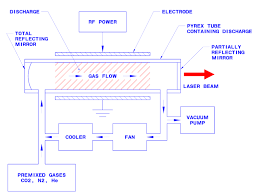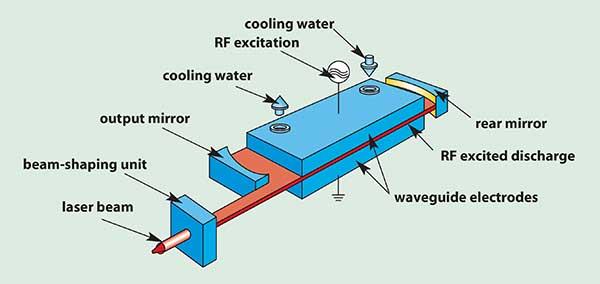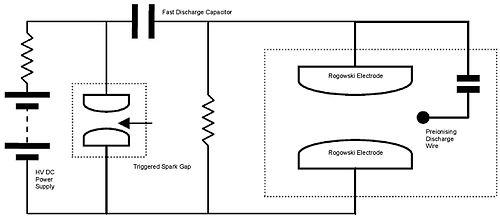The usage of CO2 laser technology, also known as carbon dioxide laser, has significantly advanced since its introduction in the mid-1960s. The leading field in the usage of CO2 laser technology is medical; other areas such as metal industries are also using the technology in several activities. Generally, laser technology has been incorporated in many areas because of its multiple applications in many aspects of everyday life. In the medical industry, various medical activities implement CO2 lasers from skin treatments to surgery. The CO2 laser technology has proven to be the safest laser technology when handled with care, making it suitable in most therapies.
History of CO2 laser
The history of carbon dioxide laser is dated back to the introduction of the theory of laser in physics by Albert Einstein in 1917. He described molecular and atomic interaction with electromagnetic energy based on spontaneous energy emission and absorption. Einstein marked his research by concluding on the possibility of stimulated energy emissions. Based on the concept explained by Einstein, Drs Schawlow and Townes developed the first microwave amplification instrument in 1959. The instrument was identified as microwave amplification through the stimulated emission of radiation (MASER). In 1960, Theodore Maimon came up with the first laser device that used ruby crystals. This was a significant achievement, and most of the clinical research based on laser technology began during this time.
The development of laser technology was at its peak during this period, and in 1961, the helium-neon laser was designed, followed by argon laser in 1962. In 1964, the CO2 laser was developed by Kumar Patel. The laser is among the best lasers that are still in existence to date. This is because the laser makes use of powerful continuous laser waves that are available.
However, the CO2 laser had limitations on the energy parameters, which resulted in frequent scarring and injuries. Anderson brought about selective photo thermolysis (SPTL), and it was successful in developing lasers that are specifically tailored for medical purposes.
The device was labeled pulse dye laser (PDL) and was primarily implemented to treat the port wine stains in young patients. In the mid-1990s, the creation of short-term duration lasers enhanced the development and operation of the CO2 lasers. During this period, the high-intensity flash lamp was introduced, which became a suitable method of treating vascular lesions. Furthermore, the modification of the CO2 laser was also enhanced by introducing intense pulsated light (IPL). To date, the transformation experienced on the CO2 laser is basically on the technical parts to enable easy usage of the instrument together with safety concerns.
CO2 laser physics
Lasers are instruments that are dependent on the stimulated radiation emission to produce light. The device comprises three main parts: the active medium, energy source, and resonating chamber. Most lasers have a population of atoms that are identified as the active medium. The active medium is a laser component with a specific size, shape, purity, and concentration. This material can vary in type depending on the type of lasers, such as solid, liquid, gas, or plasma. The gas lasers are generally composed of gases such as argon, krypton, vapor, copper, CO2, and helion-neon.
When an atom is resting, the electrons are usually orbited around the nucleus occupying the lowest energy levels. When an electron is powered by an energy source such as a chemical, electrical field, or light source, the electrons change positions and occupy the highest energy levels. When the electrons get back to their positions, photons are generated because of the energy released from the process.
C02 laser uses a mixture of carbon dioxide, nitrogen and helium gasses as its medium. The C02 laser emits infrared light with a wavelength of 10,600 nm, which is invisible to the human eye. For the light to be seen, a second gas, coaxial helium-neon (He-Ne), is introduced to the laser as a pointer. He-Ne laser has a low intensity with a wavelength of 6328 nm. The electromagnetic light produced by the He-Ne laser has the color red, which is visible. For efficient use, the C02 laser is used with the He-Ne laser for a coaxial arrangement. The alignment is often checked before use to avoid the beam from striking away from the axis.
The beam transmission system consists of a laser power supply, laser oscillator, reflecting mirrors, cutting torch, gas cylinders, water chiller, and air pump. The air pump continuously supplies clean and dry air into the laser tubes where the laser beam is generated. In the laser tube, the fusion of gasses is actuated by diodes that emit energy in the form of light. The electrons in the tube orbit around absorbing energy from an energy source; when they become excited, they orbit into higher orbitals. When they fall back into their resting orbitals, they emit energy that releases photons. The photons have the same wavelength as the excited atom; thus, all photons in the laser beam have the same wavelength.
There are two reflective mirrors in which the photons and atoms are reflected back and forth. As the photons continue to collide with the electrons, more energy is built up. One of the mirrors is partially reflective and partially transparent, allowing the photons to pass through as a beam. The emitted light energy can be either visible or invisible reliant on its wavelength, ranging from short rays (10 -11m) to long rays of wavelength (>10cm).
The laser beam is then concentrated and focused on the cutting edge by a focusing lens into a thin concentrated beam. The beam then passes a nozzle where it is magnified and focused into a single narrow point in the worktable. The water chiller is used to cool the laser tubes since after carbon dioxide has been converted to the laser, the remaining energy is converted into heat that is cooled off. Absorption is the energy conversion from laser to heat when the photon strikes the chromosphere. The process undergoes a mechanism known as selective photo thermolysis.
Working Principle and Mechanism
When an electric current is stimulated to the gas mixture, the nitrogen molecules gain the required energy; the molecules become excited. Nitrogen is preferred in carbon dioxide because it has a long period of excitement. In this state, the nitrogen molecules do not release energy either in the form of light or photons. The molecules of nitrogen release vibration of high energy, which excites the CO2 molecules. During this stage, the laser leads to the attainment of the population inversion state. The stage is characterized by a high number of excited particles compared to the non-excited particles. Energy emission in photon form is enhanced by the excitement of the nitrogen atoms. The light beam is produced whenever the excited nitrogen atoms are in contact with the cold atoms of helium.
The light produced is powerful than the ordinary light because of the surrounding mirrors of the gas tube. The mirrors have a crucial role during this stage as they reflect the light produced during the nitrogen excitement process. The light intensity keeps on increasing because of the reflections in the tube. Figure 2.0 below shows the working mechanism of the CO2 laser.

Properties of the CO2 Lasers
This type of laser is very powerful when compared to various types of lasers. The laser has a wavelength of 10.3 um, with different types of CO2 lasers ranging from 9 to 11 um. The nitrogen molecules are charged by the exiting gas, which makes them discharge energy to the CO2 molecules, making them active. The CO2 laser varies in its power which includes ten watts, kilowatts, and megawatts. The high-power laser requires fast gas flow in the tube, while the low-power laser uses laser tubes that have no laser flow in the sealed tube. The CO2 laser does not easily attain diffraction even when using the powerful types of CO2 laser.
Table 1.0: Properties of CO2 lasers.
Designs of CO2 Laser
Longitudinal-flow and transverse-flow lasers
With this design, the laser gas is pumped into the vacuum by using the vacuum pump. The design is simple and makes use of high-energy laser output. Through the discharge of current in the tube, the mixture of carbon dioxide is split into oxygen and carbon monoxide. The tube system uses the pump to continuously circulate the mixture of gases, making it efficient to remove heat loss. The transverse-flow laser is scalable to a multi-kilowatt level. The laser power can be scaled up by increasing the volumetric flow and discharge volume, which means that the discharge instability limits the maximum input power density. Depending upon the stability ensured by a particular scheme, the maximum input power density ranges from 5-50 W/cc.

Sealed-off laser
In this laser design, the pump is not used, and it’s replaced by oxygen, hydrogen, water vapor, and oxygen. These mixtures of gases help in enabling the reaction of the carbon monoxide through platinum electrodes leading to carbon dioxide. The catalytic reaction of the mixtures generates carbon dioxide. The operating lifetime of the sealed-off C02 laser can be prolonged in many ways, not only employing a gas ballast reservoir, a slightly elevated C02 partial pressure, and decreased discharge current. A sealed-offC02 laser can produce single-mode output powers of up to 0.28 W/cm of waveguide length, with discharge efficiencies of 15%.

Waveguide laser
The waveguide CO2 laser uses electrodes to guide the waves together with the cuboidal resonator. The design has a large surface area to volume ratio making it easy for heat loss removal. The small size, high power and efficiency, and tenability of these lasers offer significant advantages over other lasers. The beam quality provided by the waveguide mode is usually excellent, with typical M2 ~1.2 with a wavelength of around 9-11 µm. The low voltages permitted by a transverse pumping geometry reduce the complications often encountered with the high voltages required for longitudinal discharge gas lasers.

Transversely excited atmospheric pressure laser (TEA laser)
This design is used when a requirement of high gas pressure of around one bar with a pulse duration of 100 ns. Voltage discharge is applied across the gas flow in short pulses that range in microseconds. This laser has the advantage of combining a c02 specific wavelength of 10.6 µm, which has high energy due to short impulses. TEA lasers can use the double discharge method to initiate steady high-pressure gas discharge beneath and above atmospheric pressure. TEA lasers are used in selective or complete paint stripping and cleaning surfaces for painting in aircraft.

Application of CO2 Laser
Tattoo removal
With the introduction of the CO2 laser, the destructive processes of tattoo removal, which leads to skin problems, have been abandoned. The CO2 laser approach is preferred because it involves a bloodless field that enables the viewing of microscopic particles of the tattoo. When comparing the performance of the CO2 laser to the traditional tattoo removal methods, this method vaporizes the tattoo particles leading to their removal in a single session. The technique is also significant in removing large tattoo particles as it removes the patches in small sections, preventing the patient from contracting scars.
In the first phase of tattoo removal, the CO2 laser vaporizes the epidermis blisters, making them appear bright because of losing skin cells. Later the laser is used to remove most of the materials patched on the skin. However, other surgeons use a CO2 laser to get rid of the epidermis together with destructive methods. To prevent the hypertrophic scars during the removal of the tattoo with a CO2 laser, potent steroids are typically used, making the outcome satisfactory.
Traumatic scars
The fractional ablative CO2 laser has a significant result when treating hypertrophic scars. The treatment involves using other medical care that enhances the healing of traumatic scars and cosmetics. The treatment takes sessions between one and six, depending on the extent and size of the scar. The method has proven its validity as improvement of the tactile sensation has been reported. The patients who were involved in ablative CO2 laser treatment have shown a decrement in pruritus.
Lasers in laryngeal surgery
CO2 laser has also proven to be significant in surgery of the larynx. When treating larynx cancer, it is vital to use an external surgical method or radiotherapy. When performing a radical external surgical approach, the laryngectomy helps preserve the larynx functionality. CO2 laser surgery is essential in this surgery as it prevents the patient from losing speech. Furthermore, it helps in reducing the risk of developing swallowing problems. This is one of the situations where open surgery is not significant as it may lead to speech problems.
Lasers in otology
The CO2 laser also plays a crucial role in micro ear surgery as it helps solve problems such as Myringotomy, Stenosis, and Stapes Surgery.
Industrial (cutting and welding)
Apart from the medical usage of the CO2 laser, the technology is very useful in welding and the metal industry. The laser is used for cutting metals and in selective laser sintering (SLS). The CO2 laser is preferred because of its output power; the efficiency of the laser is enhanced through a gas jet. When cutting hard materials, steel, titanium, and carbon, very reactive gases such as oxygen are preferred. The material gets heated by the laser beam, and through interaction with oxygen, it gets burnt.
References
- A. Patel, “Anesthesia for Laser Airway Surgery”, Benumof and Hagberg’s Airway Management, pp. 824-858.e4, 2013. Web.
- J. McLaughlin et al., “Laser for Burn Scar Treatment”, Total Burn Care, pp. 648-654.e1, 2018. Web.
- T. Sawisch, G. Deeb and R. Strauss, “Use of Lasers for Minor Oral Surgery in General Practice”, Principles and Practice of Laser Dentistry, pp. 131-151, 2016. Web.
- “Carbon-Dioxide Lasers”, Spie. 2021. Web.
- “CO2 lasers“, Rp-photonics. 2021. Web.
- “How Do CO2 Lasers Work?“, Sciencing, 2021. Web.